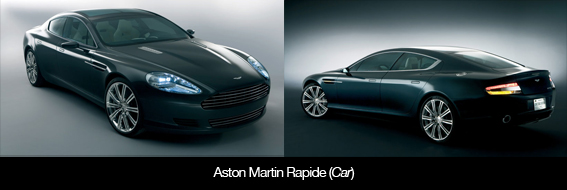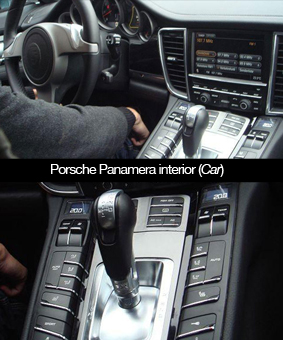
Anyone who knows me well will think it strange that I’m even interested in discussing four-door saloons, but for now I am. Looking at the European luxury car designs set to either hit the market or begin development in 2009, you’d think that they hadn’t noticed that their biggest market — the US — was in deep economic crisis. The US auto industry’s on its knees, and European imports are gathering dust in dealerships across North America. October 2008 was the worst month for car sales in the US since World War II.
European manufacturers of premium cars are already feeling the pinch, and not just in the US market. Overall new-car registration in the UK has sharply declined since June, and annual sales which were down a mere 1.56% in the first half of 2008, had plummeted to a wheel-buckling 23% by October. Both BMW and Daimler have issued profit warnings this year, BMW profits slumping by 63% in the third quarter, sparking plans by the Bavarian giant to take 65,000 units out of its 2008 production. Mini, arguably the world’s most successful small(ish) premium car has cut shifts at its UK plant, as has Aston Martin. Bently and Land Rover have also throttled back production. The squeeze is being felt all the way across to Japan where Toyota’s European sales are down by 92,000 units, spurring it to reduce output on its luxury marque, Lexus.
However, none of this carmageddon seems to be crumpling future plans within the super-luxury niche of European car manufacturers. Porsche’s new five-door, the Panamera, is already in the steel and being drooled over from Top Gear to Car magazine. It’s set to hit the market in early 2009. Aston Martin has no less than five projects earmarked for the coming year, and three of them involve brand new models — the four-door Rapide, the 700bhp One-77, and the resurrection of Lagonda. Lamborghini’s own four-door, the Estoque, is still a show car, and while production is estimated to be years away, development will begin in 2009.
 The US economic slump has triggered a global financial crisis that will certainly dial back spending habits in the luxury sector, affecting more than just cars. Or will it? Aston Martin’s boss, Dr Ulrich Bez, doesn’t seem to think so. Bez believes that the more exclusive a product is, the less it will be influenced by its environment. “The product has to deliver something really special and unique to a customer.” Sure. Like a learjet. And we all know how many of those are being snapped up today. So how special and unique are these new offerings by Europe’s luxury car brands?
The US economic slump has triggered a global financial crisis that will certainly dial back spending habits in the luxury sector, affecting more than just cars. Or will it? Aston Martin’s boss, Dr Ulrich Bez, doesn’t seem to think so. Bez believes that the more exclusive a product is, the less it will be influenced by its environment. “The product has to deliver something really special and unique to a customer.” Sure. Like a learjet. And we all know how many of those are being snapped up today. So how special and unique are these new offerings by Europe’s luxury car brands?
While Aston Martin’s One-77 supercar certainly is the most exciting new car on the horizon, it’s not really a significant development in this context. It may take Aston out of its tried and tested GT territory and into Ferrari land, but it still won’t be manufactured in significant enough numbers to actually influence the industry. Nissan’s new 370Z and the Hyundai Genesis Coupe are both mass market sports cars, and sales of these will be more indicative of the industry’s health.
What is a significant development is the arrival of three new luxury saloons.

Aston Martin’s first new entrant will be the Rapide, tipped to come out in the third quarter of 2009, priced between 138,000-160,000 euros. This four-door saloon will go up alongside other new entrants such as the Porsche Panamera and Lamborghini Estoque. In usability, the Rapide will have to compete against existing luxury saloons like the Maserati Quattroporte, Mercedes S-class, and BMW 7-series. While the Aston’s 6.0-litre V12 dishes out around 500bhp and 420lbft of torque, performance is still theoretical, with no official stats released by Gayden. Rumours are of 370kmp/h top speed, but an early Rapide prototype lapped the Nurburgring in nine minutes earlier this year, which isn’t really much better than a Ford Focus RS. However, Astons were never really so much about speed as style. The Rapide’s strongest point is its absolutely stunning looks. There’s really nothing to pick holes in no matter which angle you take. So desirability will be something to make the Rapide stand out. That and the price tag.

Next up is the Panamera, Porsche’s five-door saloon/hatch/estate. Like the Rapide, what makes it most unique on the road is the fact that it’s a Porsche. The Panamera has caused at least as much of a sensation since it was announced as did the Cayenne. While no one could really understand a Porsche SUV, a luxury saloon seems to make sense to the brand’s fans. Not that Porsche cares — arguably the world’s most successful car manufacturer, with higher profits per unit than anyone else — they’ve never really listened to what Porschephiles have to say. Technologically driven, Porsche has still been able to infuse desirability into their machines. The Panamera is certainly the most tangible of next year’s new arrivals, having already been driven and reviewed by the experts. Just as the Rapide sticks faithfully to Aston’s design ethos, the Panamera looks every inch a Porsche. Just bigger. And the 500bhp, 516lbft 4.8-litre twin-turbo V8 is at the front. A definite edge over the Rapide will be the fact that the Panamera weighs in under two tons, transferring power and torque equivalent to the Aston into direct performance.
 The interior of the Panamera too is all Porsche, with individual reclining seats (no three-seat rear bench here) and a huge centre console that divides the cabin. Since no one’s seen the interior of a Rapide as yet, we can’t compare the two, but so far the Panamera seems to fall short of the comfort levels provided by, say, an S-class. However, the rear seats fold down, increasing the 450-litre boot and basically turning the Panamera into a station wagon. That tailgate is definitely unique in this class. So while this isn’t exactly the prettiest pony in the stable, it’s certainly unique — finally a Porsche for driver and passengers.
The interior of the Panamera too is all Porsche, with individual reclining seats (no three-seat rear bench here) and a huge centre console that divides the cabin. Since no one’s seen the interior of a Rapide as yet, we can’t compare the two, but so far the Panamera seems to fall short of the comfort levels provided by, say, an S-class. However, the rear seats fold down, increasing the 450-litre boot and basically turning the Panamera into a station wagon. That tailgate is definitely unique in this class. So while this isn’t exactly the prettiest pony in the stable, it’s certainly unique — finally a Porsche for driver and passengers.
Lamborghini’s Estoque is probably the most distance away from actual production, with models expected to be in showrooms only by 2011. Also, of the three new saloons, it’s probably (to me, anyway) the one with the least family resemblance. Sure, it’s got those big Gallardo air intakes, 22-in wheels, and is just 1.35m tall, but this is no 370kmp/h supercar. The Estoque (named after a bullfighter’s sword, like the 1960’s Espada GT) is a huge five metres long and won’t push out at faster than 270kmp/h. From the rear quarter, the Estoque looks more Alpha Romeoesque than Lamborghini. It’ll also be the only one of the three available in diesel. The most likely powerplant will be the Gallardo’s V10 rather than the Murcielago’s V12, which means that while the Estoque won’t be supercar fast, it’ll still sprint to a 100kmp/h in under five seconds. So like the Panamera and the Rapide, what makes the Estoque truly unique is that it’s the only saloon manufactured by its marque.

While Aston Martin hasn’t released any estimates for sales figures on the Rapide (which will be produced entirely by Magna Steyr in Graz, Austria), Porsche plans to manufacture 20,000 Panameras a year at its plant in Leipzig, with forecasted sales per annum in the region of 30,000 once production’s at maximum revs. That may seem like a lot of Porsches to sell, but is not really much when you consider Mercedes sales of 85,000 S-classes a year. Lamborghini plans to sell 2,500-3,000 of the saloon, and given that they sell only 2,400 cars a year altogether, it’s an indication of how important the Estoque is.
Now all this might seem a bit silly in an environment of plummeting car sales across the western world. Or does it? All three of these manufacturers are most likely looking east rather than west. In emerging markets like China, big luxury saloons are definitely what the upper echlons of money are looking at rather than boys’ toys like a DBS or Gallardo. And in a market dominated by Audi A8s, BMW 7-series, and Mercedes S-classes, what would be more desirable than owning an Aston Martin, Porsche, or Lamborghini that can provide you with both reasonable performance and luxury? Certainly, this class of car is far more likely to weather the volatile times the car industry is facing than would a two-door supercar.

Very interesting article. I too think the hunger for luxury and super luxury cars will never fade away, even in bad times. Bad times are for the average people, the ones who buy Toyota’s I suppose. Every car-maker is eying the East now – luxury or otherwise.
When TopGear reviewed Bugatti Veyron in Abu Dhabi, UAE, sometime ago, they didn’t have to ship the car – they easily found 5 to choose from! I would think twice before letting someone like Jeremy Clarkson fiddle with my £800+k toy; but they found FIVE volunteers! Tells you something about the rich, doesn’t it? They wouldn’t stop buying their Christmas presents (oops, Ramadan presents) and there would always be people like Sheikh Mohammed who has a fleet of Rolls-Royce taxis for his Burj Al Arab. Dubai seems to be the only Gulf State that’s hit the crisis, everywhere else the petro-dollars are still doing good.
Also an interesting development is the “family-sports car” concept; like the Masserati and the Porsche above. Not only them, even Lexus is doing it now with the new IS 250 topless. A sports car for the family man!
I guess the future for the Lamborghini’s and Bugatti’s wouldn’t be as bleak as for the Chevy’s and Nissan’s – there is always a crazy-rich guy somewhere, craving for the best of the lot.
I think what the premium sports car manufacturers are realizing is that demand for supercars in the west will decline, at least in the near future, given the double whammy of the economic down turn coupled with stricter emission controls. Supercar sales may not be able to sustain profits for these companies, even in the east, where status is often equated to size and splendor rather rather than speed and performance. Therefore a Lambo saloon makes a lot of sense when it comes to units sold.